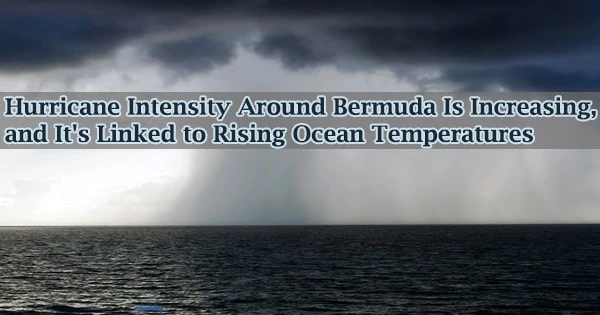Due to rising water temperatures in the region, hurricane maximum wind speeds in the subtropical Atlantic around Bermuda have more than doubled on average over the last 60 years, according to a new study.
Hurricanes gain strength by taking energy from the warm ocean surface through air-sea heat fluxes, therefore a warmer ocean can result in stronger hurricanes.
Improved hurricane wind speed estimates will aid in determining the appropriate level of response in advance of the storm, potentially limiting damage in Bermuda.
Although experts are divided on whether climate change will result in an increase in the number of hurricanes, there is a greater likelihood that warming ocean temperatures and rising sea levels would amplify storm intensity and effect. Without action to make coastal (and inland) areas more resilient, stronger hurricanes would be significantly more costly in terms of destruction and lives.
Between 1955 and 2019, the mean hurricane intensity near Bermuda, as measured by maximum wind speed, increased by over 6mph every decade, from 35 to 73mph. At the same time, the region’s sea surface and subsurface temperatures rise by up to 1.1°C, providing more energy for hurricanes to intensify.
The study, which was published in Environmental Research Letters, also uses the average upper ocean temperature in the top 50m layer to construct a predictor for the severity of hurricanes traveling through the Bermuda area.
The research demonstrates the greater relevance of upper ocean heat versus sea surface temperatures alone in the prediction of hurricane intensity. Preliminary testing with the recent passage of Hurricane Paulette shows promising results that this technique could be further developed into an additional operational tool for forecasters locally.
Mark Guishard
Samantha Hallam, the lead author of this paper from the University of Southampton and the National Oceanography Centre (NOC), said, “The approach we used could provide a better way to predict Bermuda storm intensity than current theory or operational methods alone. It could also be used elsewhere in the subtropical Atlantic where there is a shallow mixed layer depth, typically north of twenty-five degrees north.”
“We used hurricane potential intensity theory, locally-based weather balloon soundings, surface and upper ocean observations of conditions in and around hurricanes passing within 100km of Bermuda over the last 65 years (including direct hits and ‘near-miss’ storms).”
Mark Guishard, co-author and Director of the Bermuda Weather Service said, “the research demonstrates the greater relevance of upper ocean heat versus sea surface temperatures alone in the prediction of hurricane intensity. Preliminary testing with the recent passage of Hurricane Paulette shows promising results that this technique could be further developed into an additional operational tool for forecasters locally.”
These conclusions are based on a statistical examination of storm trajectories within 100 kilometers of Bermuda from 1955 to 2019. The Bermuda Institute of Ocean Sciences used surface and deep ocean temperature readings from the Bermuda Atlantic Times Series (BATS) Hydrostation S program.
The link between climate change and hurricane frequency is more complicated. The number of storms is anticipated to stay the same or even decline, with the most extreme storms seeing the most growth.
Some models predict no change or a minor drop in storm frequency in the twenty-first century, while others predict an increase. More recent research reveals a trade-off between hurricane intensity and frequency, with fewer storms forming as warmer waters boost hurricane intensity.
The University of Southampton, the National Oceanography Centre, the Bermuda Institute of Ocean Sciences, and the Met Office collaborated on this project, which was sponsored by the Natural Environmental Research Council (NERC) and the Bermuda Institute of Ocean Sciences.
















